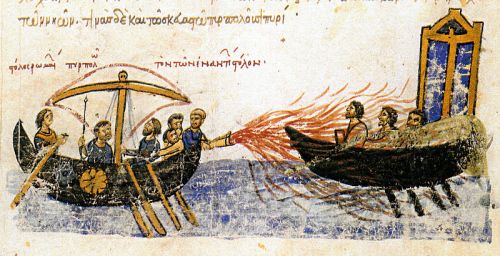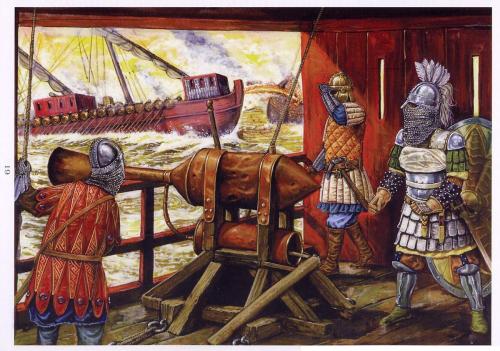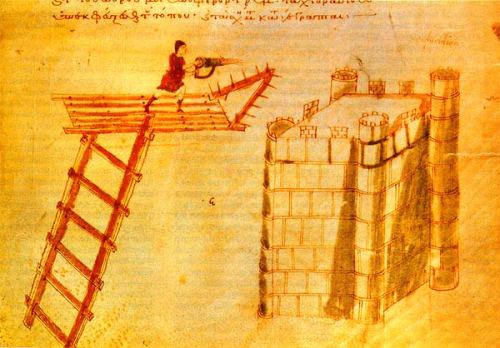GREEK FIRE: THE SECRET WEAPON OF THE BYZANTINE EMPIRE
19/02/2013

A Byzantine depiction of Greek fire in a miniature from the manuscript of Skylitzes.
-
The “Greek fire” or “sea fire” or “liquid fire” (as it was usually called by the Byzantines themselves) or “Median fire” was one of the strongest and most mysterious weapons of the Byzantine Empire (considering their composition). The Arabs called “naphtha” (‘naft’) their own corresponding incendiary substance for military purposes, a term which usually means the natural unrefined oil or the refined products of its distillation. The use of flammable substances in military operations on land and sea, was known to the Greeks as early as the Classical Period, who developed it especially during the Hellenistic Period. The term “Median/Medic fire” which was synonymous to the “Greek fire” in the Byzantine written sources, indicates that the Southern Iranians (Medes and Persians) used an early form of it (already from the pre-Achamenid Median period according to literary evidence). The Chinese of the same period also used their own corresponding incendiary substances. Moreover, the burning of the enemy fortifications, troops, ships, etc., was one of the main military pursuits already from the high antiquity. Concerning the Iranian peoples, the development of inflammatory substances as weapons of war, was aided by the presence of abundant reserves of crude oil in Iran, Mesopotamia and the North Arabian Peninsula, areas which were under the control or the political influence of the Medes and the Persians.
The reliable Arabic “Book of Sources” quotes that the Muslims used since 674 AD a substance which seems to have been an early form of “liquid fire”. The Persian chronicler Rashid al-Din mentions the use of incendiary machines by the Arab and Iranian Muslims who invaded the Indus valley in 710 AD. Nevertheless, the Byzantine chronicler Theophanes (9th c.) and other Byzantine sources report that Callinicos – a Greek engineer from Heliopolis in Syria (a descendant of the Greek Hellenistic settlers in Syria) – invented the ‘liquid fire’, which was first used by the Byzantines during the first Arab siege of Constantinople (674-678 AD). Because of its origins and its use by the Byzantine Greeks, the liquid fire became known in Europe and then worldwide, as the “Greek Fire”.

A modern depiction of a Byzantine flamethrowing warship, using Greek Fire against an enemy ship (probably Arabian). In the foreground: the mechanism and the siphon of ejection of Greek fire in the interior of a Byzantine Dromon (artwork by Giorgio Albertini, copyright: Concord publications & G. Albertini)
-
The imperial forces used the new weapon several times in the future, a weapon that seems to have caused terror to their Arab opponents, although the later also used some powerful inflammatory substances as early as 674 AD. It should be noted that after the destruction of the Arab-Egyptian fleet by the Byzantine navy in Cyprus using Greek fire (747 AD), there is no mention in Greek or Muslim sources of any aggressive action of the Egyptian navy against the Byzantine Empire for a century. Nor does the same sources quote any aggressive action of the fleet of the Arabo-Syrians for about 60 years after the destruction of their Egyptian comrades in Cyprus. This long inertia of the two most powerful Islamic fleets probably indicates their fear of the Greek fire. It should also be noted that the numerous Egyptian losses in Cyprus is not the reason for this inaction, because as it has been demonstrated by the aggressive action and particularly by the great feasibility of shipbuilding and manning of the Egyptian and the Syrian navy, these losses (in ships and men) could be replaced in a short time.
The conclusion of the aforementioned references and observations, is that the Muslim armies and fleets had sufficient incendiary substances, but not of the validity and effectiveness of the Byzantine Greek fire. Chances are that Callinicos perfected an inflammatory weapon that existed since ancient times in Greece and the Middle East, producing an improved incendiary mixture which was decisively superior to those of the Arabs and Iranians and in general the peoples of Asia. Callinicos obviously used largely the Greek/Hellenistic technology of his Syrian homeland, one of the most outstanding centers of culture and power in the Hellenistic Age. Syria remained a center of the Greek culture also after its conquest by the Arabs (7th c. AD). Callinicos’ family were Greek refugees from conquered Syria who found shelter probably in Constantinople or in a Byzantine province.

A Byzantine soldier armed with a siphon of ejection of some incendiary substance (a “flamethrower”) in a high platform of siege of an enemy city. Byzantine miniature.
-
The Greek fire consisted at least of crude oil, sulfur and a few other known substances. But there were several unknown substances/components. Equally unknown is the composition in which the various components of the Greek fire were mixed to produce the weapon. As it is evidenced by the sources, some of the qualities that made the Greek fire superior to the Muslim incendiary substances, were that it was highly resistant to extinction (some kind of ‘waterproof’) and it could be burned for hours in the surface of the sea. Probably these were its main advantages. In some cases, the Greek fire was bestrewn in the sea around the enemy ship and then it was ignited thus rapping the ship in flames, according to an Islamic reference. Another evidence of its superiority, is that while the Arab sources mention many details about the composition and preparation of their ‘naphtha’, the Byzantine sources are silent concerning these issues about the Greek fire. It is considered that there was an imperial ban on manufacturers of the liquid fire, not to disclose the secrets of its composition and preparation. For this reason, its exact composition remains a mystery to this day. The Byzantine Empire was able to protect effectively its strongest and most secret weapon, so it is likely that we will never know its composition, despite several diligent experimental attempts made by historians and researchers. The Byzantines took forever with them the secret, when Constantinople succumbed to the Ottoman hordes on May 29, 1453.
-
Periklis Deligiannis
-

An impressive reconstruction of the disaster caused by the Greek Fire (Late Byzantine period) . Greek Fire was essentially an early weapon of mass destruction.
-
No comments:
Post a Comment